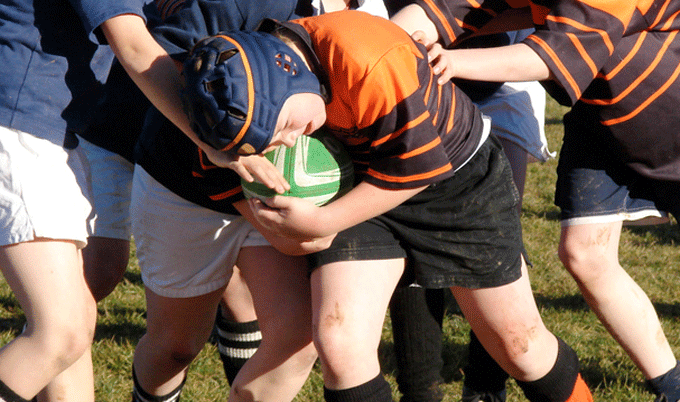Ban kids rugby tackling
Experts call for a ban on children rugby tackling
Published on: 13 July 2017
In light of the Lions' recent rugby success, Newcastle University experts warn steps need to be taken to ensure children’s safety when they play the sport.
The call comes as their research reveals that serious injuries – including concussion – are most likely to be caused by rugby tackling and should be removed from school sport.
They are now calling on governments to protect children under the United Nations Convention on the Rights of the Child by removing this avoidable harm.
The study, published today in the British Journal of Sports Medicine, re-examined a large body of existing evidence on the rates and risks of injuries in sport. It came in response to an earlier article in the same journal by World Rugby employee Ross Tucker and colleagues which had put forward the case that rugby was no more injury prone than other sports.
In the new updated review, the Newcastle University study has found further evidence to support the recent call to remove tackling and other forms of harmful contact from school rugby.
Lead author Professor Allyson Pollock, Director of the Institute of Health and Society at Newcastle University said: "We need to act now to protect our children from injuries from collision sports. Our evidence shows the high injury rate in rugby for children across all age groups.
“There is also a consensus that collision sports including rugby have higher rates of injury than non-collision contact sports such as football. Rugby has the highest rate of concussion out of any youth sport.
“We know other countries are taking this issue seriously and leading the way. Rule changes have been introduced in youth ice-hockey in Canada as this is the only proven method of quickly reducing the high rates of injury."

Injury risks
The paper reports how concussion can lead to long-term harm including a recent study which found girls were three or four times more likely to be affected by symptoms for 28 days than boys. This is a particular concern given the increasing number of female rugby players.
The authors highlight that concussion, and head injury more generally, has also been found to be associated with an increased risk of dementia and Alzheimer’s disease.
The paper also re-examined claims that previous studies had inflated the risk of injury or that removing the tackle from school rugby might lead to an increase in injury rates at later ages, but found no evidence to support these theories. Contrary to this, the researchers found strong evidence from Canada that removing the "body check" from youth ice-hockey, where a player deliberately makes contact with an opposing player to separate them from the ice-puck, has led to a 67% reduction in concussion risk.
Co-author Graham Kirkwood of Newcastle University said: "Under the United Nations Convention on the Rights of the Child, governments have a duty to protect children from the risks of injury.
“We are proposing a compromise approach where children as a definable vulnerable group of athletes with unique risks require specific measures as a way of lessening the risk of injury.
“School rugby provides an ideal modifiable environment to implement the safety measure of removing the tackle."
The experts’ concerns have been raised as Rugby Football Union is running a programme of introducing the sport to a million children in state schools across England, which is due to finish in 2019.
Professor Pollock added: “All the evidence available on rugby injuries shows there is a high risk of injury and that the tackle is where most of these injuries occur. Chief Medical Officers need to make ministers aware of this evidence and World Rugby and ministers should immediately take a cautionary approach to protect children from avoidable harms by removing the tackle from school rugby.”
Reference: Evidence in support of the call to ban the tackle and harmful contact in school rugby: a response to World Rugby. Pollock AM, White AJ, Kirkwood G. British Journal of Sports Medicine 2017.
Latest News
Heading 3 example
Text only. For subheading use ‘Heading 3’
Lorem ipsum dolor sit amet, consectetur adipiscing elit. Donec vel sapien lectus. Aliquam consectetur vitae tortor mattis sodales. Donec id quam id nulla tristique vestibulum. Ut vitae orci aliquam massa varius dapibus. Vivamus aliquet, lorem sit amet semper ultricies, ex tortor molestie felis, at ultrices tellus ligula vitae est. Sed gravida tortor sapien, in iaculis quam vestibulum vel. Duis et quam nec metus pharetra placerat. Donec in tellus pretium ex sagittis posuere. Nunc varius, libero at suscipit commodo, magna lacus facilisis velit, sed pellentesque magna eros vel dolor. Donec pretium neque ultrices, condimentum turpis non, porttitor neque. Suspendisse fermentum at lectus scelerisque mattis. Nam augue justo, iaculis quis euismod et, viverra in elit. Aliquam vitae justo malesuada, sodales urna et, aliquam nunc. Nulla placerat neque quis odio molestie, mattis bibendum turpis pellentesque.



